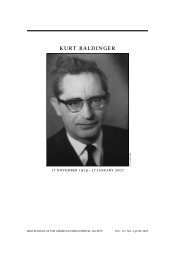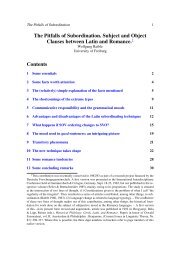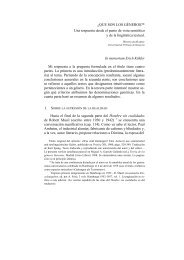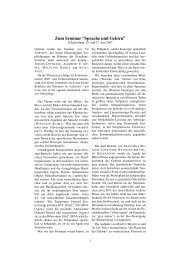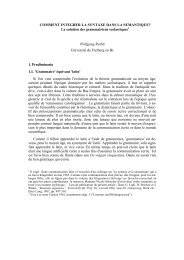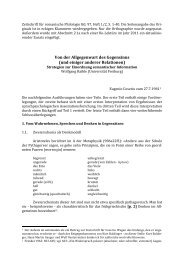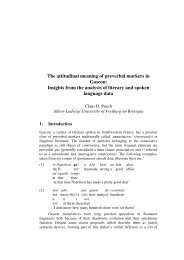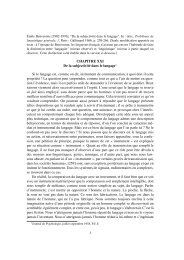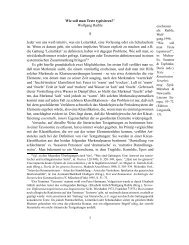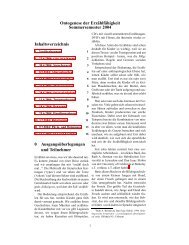A Summary of Role and Reference Grammar
A Summary of Role and Reference Grammar
A Summary of Role and Reference Grammar
You also want an ePaper? Increase the reach of your titles
YUMPU automatically turns print PDFs into web optimized ePapers that Google loves.
Agents are willful, controlling, instigating participants in states <strong>of</strong> affairs, while patients are<br />
strongly affected participants. Positing these as endpoints on the cline makes it possible to locate<br />
the other role-types with regard to them. The DO <strong>of</strong> lexicalized agency always co-occurs with<br />
do´ (x, ..., which defines effector <strong>and</strong> its subtypes, <strong>and</strong> therefore the first two columns are<br />
closely related to each other; both <strong>of</strong> them express participants which do something. At the other<br />
end <strong>of</strong> the continuum are patient <strong>and</strong> theme, etc. The single argument <strong>of</strong> state predicate´ (x)<br />
includes those participants which are crushed, killed, smashed, shattered, broken, destroyed, etc.,<br />
while the second argument <strong>of</strong> predicate´ (x, y) includes those participants which are placed,<br />
moved, thrown, given, possessed, transferred, seen, heard, loved, etc. In terms <strong>of</strong> affectedness,<br />
the former type <strong>of</strong> participant is much more affected than the latter, hence the placement <strong>of</strong> the<br />
single argument <strong>of</strong> state predicate´ (x) at the end <strong>of</strong> the hierarchy. Into the middle <strong>of</strong> the continuum<br />
falls the first argument <strong>of</strong> predicate´ (x, y). If it is contrasted with the first argument <strong>of</strong><br />
do´ , it is clear that seeing, thinking, believing, possessing, etc. are less agent-like than are<br />
speaking, doing, moving, performing, consuming, hence their placement to the right <strong>of</strong> effector,<br />
etc. If, on the other h<strong>and</strong>, the contrast is with the second argument <strong>of</strong> predicate´ (x, y), then the<br />
reverse conclusion follows. Seeing, thinking, liking, believing, etc. involve some kind <strong>of</strong> internal<br />
activity (mental, emotional or perceptual) on the part <strong>of</strong> the participant, whereas being seen,<br />
being thought about, being liked or being believed does not require any action or effort <strong>of</strong> any<br />
kind on the part <strong>of</strong> the participant. Hence the participant referred to by the first argument is more<br />
active <strong>and</strong> hence more agent-like than the participant referred to by the second argument, <strong>and</strong><br />
accordingly, the first argument is closer to the agent end <strong>of</strong> the hierarchy than the second argument.<br />
Thus, the place <strong>of</strong> the different argument positions in the continuum in Figure 12 is indicative<br />
<strong>of</strong> the semantic contrasts among them.<br />
The second type <strong>of</strong> semantic role plays a crucial role in the theory; macroroles act as the primary<br />
interface between the LS <strong>and</strong> syntactic representations. There are only two macroroles,<br />
actor <strong>and</strong> undergoer, corresponding to the two primary arguments in a prototypical transitive<br />
relation. They are called ‘macroroles’ because each subsumes a number <strong>of</strong> specific thematic relations.<br />
Consider the range <strong>of</strong> thematic relations that can function as subject <strong>and</strong> direct object in<br />
English. The subject NPs <strong>and</strong> their thematic relation are in italics; the direct object NPs <strong>and</strong> their<br />
thematic relations are in boldface.<br />
(12) a. The farmer killed the duckling. Effector/Agent Patient<br />
b. The rock broke the window. Effector/Inst. Patient<br />
c. The lawyer received the summons. Recipient Theme<br />
d. Many tourists saw the accident. Perceiver Stimulus<br />
e. Sally presented Bill with the award. Effector/Agent Recipient<br />
f. The mugger robbed Sam <strong>of</strong> $50. Effector/Agent Source<br />
g. The clown showed the child a trick. Effector/Agent Perceiver<br />
(13) a. The duckling was killed by the farmer.<br />
b. The window was broken by the rock<br />
c. The summons was received by the lawyer.<br />
d. The accident was seen by many tourists.<br />
e. Bill was presented with the award by Sally.<br />
f. Sam was robbed <strong>of</strong> $50 by the mugger.<br />
g. The child was shown a trick by the clown.<br />
15



